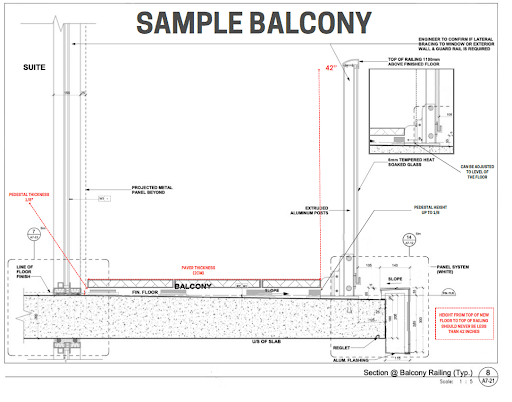Understanding Railing Height Code and Its Importance for Balcony Flooring Installation
When planning a balcony flooring project, it’s crucial to understand the railing height code to ensure safety and compliance with local building regulations. In Ontario, the Building Code specifies the necessary height for guardrails on residential balconies. This article will guide you through these requirements and explain why considering the new finished floor height after flooring installation is essential.
Ontario Building Code (OBC) Guard Rails Requirements
The Ontario Building Code (OBC) mandates that any residential balcony 5′-11″ (1.80m) above ground level must have a railing at least 42 inches (1067mm) tall. This measurement is taken from the walking surface of the balcony to the top of the railing. Ensuring your balcony meets this standard is critical for both safety and compliance.
Why Railing Height Matters with New Flooring
Adding new flooring to your balcony can raise the walking surface height, potentially making existing railings non-compliant. Here’s why it’s important to account for this change:
- Safety Compliance: A raised floor can reduce the effective height of the railing, making it less safe. Ensuring the railing remains at least 42 inches above the new floor level helps prevent falls and accidents.
- Regulatory Compliance: Ensuring the railing height meets the code after installation helps avoid legal issues and fines. Non-compliance can lead to mandatory adjustments, causing additional costs and delays.
- Aesthetic and Functional Integrity: Proper railing height ensures the balcony remains both visually appealing and functional. An appropriately high railing provides a sense of security while maintaining an unobstructed view.
Steps to Ensure Compliance
- Measure Current Railing Height: Before installation, measure the existing railing height from the current floor surface.
- Calculate New Floor Height: Determine the height of the new flooring material you plan to install. Common materials include deck tiles, porcelain pavers, and other modular flooring systems.
- Adjust Railing If Necessary: If the new floor height reduces the railing height below 42 inches, consider options such as extending the railing, using thinner flooring materials, or consulting with a professional to modify the railing structure.
Additional Considerations
- Material Selection: Choose flooring materials that are durable and suitable for outdoor use. Consider the thickness of these materials and how they will impact the overall height of your balcony floor.
- Professional Installation: Hiring a professional can ensure that the installation is done correctly and that all safety and regulatory requirements are met. Professionals can also provide advice on the best materials and methods for your specific balcony.
- Maintenance and Upkeep: Regular maintenance of your balcony flooring and railings is essential to ensure long-term safety and compliance. Inspect the railings periodically to check for any wear and tear or structural issues.
Visual Guide to Railing Height and Flooring Installation
The following diagram illustrates the key measurements to consider when installing new balcony flooring. It emphasizes the importance of maintaining a minimum railing height of 42 inches from the top of the new floor to ensure safety compliance.

Key points:
- Paver Thickness: 2cm
- Pedestal Height: Adjustable from 1/8 of an inch to 40 inches when required. Generally, the pedestals used on condo balconies are under an inch.
- Railing Height: Must be at least 42 inches from the new floor surface
By carefully measuring and adjusting these elements, you can ensure your balcony remains both safe and compliant with building regulations.
FAQ
- How high should a balcony railing be? In Ontario, the building code requires balcony railings to be at least 42 inches (1067mm) high for any balcony that is 5′-11″ (1.80m) above the ground. This height ensures safety by preventing falls.
- What is the height of balcony railings in Canada? The height requirement for balcony railings in Canada can vary by province, but generally, for residential balconies, it is 42 inches. It’s essential to check local building codes for specific regulations.
- Is railing height 36 or 42 inches? For residential balconies, the railing height is typically 42 inches. However, for certain applications like interior railings or lower-height decks, the requirement can be 36 inches. Always refer to local building codes.
- What is the height code for railings in Ontario? In Ontario, the building code specifies that guardrails on balconies must be at least 42 inches high if the balcony is more than 5′-11″ above ground level. This ensures adequate safety for elevated structures.
- What is the standard balcony railing height? The standard height for balcony railings is generally 42 inches for residential buildings. This height helps to prevent falls and meets most building safety requirements.
- What is the railing on a balcony called? The railing on a balcony is commonly referred to as a “guardrail” or “balustrade.” It serves as a protective barrier to prevent falls from the elevated surface.
- How do you measure a balcony railing? To measure a balcony railing, measure from the walking surface of the balcony to the top of the railing. Ensure this height meets the required 42 inches to comply with safety regulations.
Conclusion
Understanding and adhering to the railing height code is crucial when installing new balcony flooring. By taking into account the new finished floor height, you can ensure your balcony remains safe, compliant, and visually pleasing. For expert advice and installation services, contact Skyscapes today.
Call Us Today! 647-948-1272







